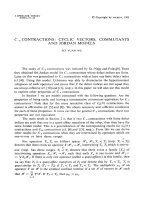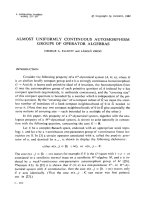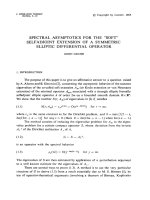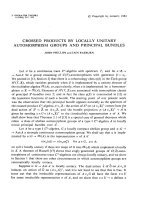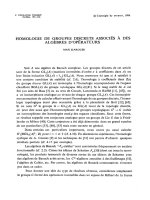Báo cáo toán hoc:" Almost all trees have an even number of independent sets " ppt
Bạn đang xem bản rút gọn của tài liệu. Xem và tải ngay bản đầy đủ của tài liệu tại đây (120.69 KB, 10 trang )
Almost all trees have an even number
of independent sets
Stephan G. Wagner
Department of Mathematical Sciences
Stellenbosch University
Private Bag X1, Matieland 7602, South Africa
Submitted: Mar 28, 2009; Accepted: Jul 21, 2009; Published: Jul 31, 2009
Mathematics Subject Classifications: 05C30; 05A16, 05C05, 05C69
Abstract
This paper is devoted to th e proof of the surprising fact that almost all trees
have an even number of independent vertex subsets (in the sense that the proportion
of those trees with an odd number of independent sets tends to 0 as the number of
vertices approaches ∞) and to its generalisation to other m oduli: for fixed m, the
probability that a randomly chosen tree on n vertices has a number of independent
subsets that is divisible by m tends to 1 as n → ∞.
1 Introduction
The number of independent vertex subsets is one of many interesting graph parameters
that have been studied in the past. It was introduced to the mathematical literature
in a paper by Prodinger and Tichy in 1982 [21], where it was shown — amongst other
things such as explicit formulæ for various classes of graphs — that the star and the
path maximize resp. minimize the number of independent sets among all trees of given
size. In subsequent works, Kirschenhofer, Prodinger and Tichy [11, 12] investigated the
average number of independent sets in certain classes of rooted trees (such as binary
trees), providing some nice combinatorial results.
Generally, the number of independent sets is a parameter that is particularly well-
studied for trees and tree-like structures (forests, unicyclic graphs, etc.): a paper of Lin
and Lin [1 5] extends the aforementioned results, and in recent years a wealth of literature
on the so-called extremal problem (given a class of graphs, determine those members of
the class that maximize or minimize the number of independent sets) has developed; see
for instance [9, 14, 19, 20, 23] for some nice results in this direction. Part of the interest
is due to the fact that this parameter plays a role in mathematical chemistry, where it is
the electronic journal of combinatorics 16 (2009), #R93 1
known as the Merrifield-Simmons index [14, 17, 23]. A problem that arises in this context
is the inverse problem: determine a graph within a given class (such as the class of all
trees) with a given number of independent sets. It is an open conjecture [13] that all but
finitely many positive integers can be represented as the number of independent sets of
some tree. A partial result in this direction is due to Linek [16] who was able to show by
means of a clever yet elementary construction that every positive integer is the number
of independent sets of some bipartite graph.
While there are interesting distribution results for the sizes of independent sets in
graphs (see [3]), there is no distribution result known for the number of independent sets
itself yet. Considering the number of independent sets of a randomly chosen tree on n
vertices as a random variable, does it (suitably normalized) tend to a limiting distribution
as n → ∞? Results in this direction a r e known for many other tree parameters, such as
the height or the Wiener index (the sum of all the distances between pairs of vertices; see
[5, 10]).
The present paper provides some explanation why the inverse problem for trees is
harder than it might seem to be and why it is not so easy to obtain distribution results of
the aforementioned type either. Suprisingly, it turns out the number of independent sets
of a randomly selected tree is more likely to be even than to be odd; indeed, the probability
that the number is even tends to 1 as the number of vertices approaches ∞. Even more
generally, for any fixed modulus m, the probability that the number of indep endent sets
of a randomly selected tree is divisible by m tends to 1 as the number of vertices increases.
There seems to be no obvious intuitive explanation for this phenomenon, considering tha t
it was shown for other parameters (e.g. the number of leaves [1, 4] or again the Wiener
index [22]) that the number of trees with even parameter value is asymptotically the same
as the number of trees with odd parameter value. There is also no particular evidence
if one considers small tr ees or special cases only: for instance, a star on n vertices has
exactly 2
n−1
+ 1 independent vertex sets, which is odd for n > 1. The result is only
asymptotic in nature.
More precisely speaking, we will prove the following:
Theorem 1 Let m > 1 be a fixed integer, let T
n
denote the set of all trees on n ve rtices,
and let T
(m)
n
be the set of all trees with the property that the number of independent sets
is divisib l e by m. There exists a constant c < 1 that only depends on m such that
|T
n
\ T
(m)
n
|
|T
n
|
= O(c
n
).
By no means this implies that there are “few” trees with e.g. an odd number of
independent sets. Their numb er still increases exponentially, and we will show in Section 3
that the constant c is not too far away from 1 in the case m = 2.
the electronic journal of combinatorics 16 (2009), #R93 2
2 Proof of the main result
We will make use of a recursive formula for the number i(T ) of independent sets of a
rooted t ree T . To this end, we have to introduce an auxiliary parameter i
0
(T ), which
denotes the number of independent sets of a rooted tree T that do not contain the root of
T . If T
1
, T
2
, . . . , T
k
are the subtrees of T (see Figure 1), we have the following formulæ,
which are easy to verify:
i(T ) =
k
j=1
i(T
j
) +
k
j=1
i
0
(T
j
), i
0
(T ) =
k
j=1
i(T
j
). (1)
Now we define subsets R
(m)
n
(r, s) of the set R
n
of all rooted trees on n vertices as follows:
R
(m)
n
(r, s) = {T ∈ R
n
: i(T ) ≡ r mod m, i
0
(T ) ≡ s mod m}.
Furthermore, we write R =
n∈N
R
n
and R
(m)
(r, s) =
n∈N
R
(m)
n
(r, s) for all r, s. If T
is now a rooted tree with subtrees T
1
, T
2
, . . . , T
k
, and T
j
∈ T
(m)
(r
j
, s
j
) for certain r
j
and
s
j
, then it is possible to determine i(T ) and i
0
(T ) (modulo m) from the values of the r
j
and s
j
only. In particular, it should be noted that if one of the subtrees is an element of
R
(m)
(0, 0), then so is T .
r
T
1
T
2
T
k
. . .
Figure 1: A rooted tree and its subtrees.
Next we need the following lemma:
Lemma 2 For any in teger m > 1, the se t R
(m)
(0, 0) is nonempty.
Proof: We make use of the simple fact (see [21]) that i(P
n
) = F
n+2
, where P
n
is the path on
n vertices and F
k
denotes the k-th Fibonacci number (F
0
= 0, F
1
= 1, F
n
= F
n−1
+F
n−2
).
It is well known that for any positive integer m, there exists a Fibonacci number (ot her
than 0) that is divisible by m (since the sequence of Fibonacci numbers is periodic modulo
m and contains the element F
0
= 0). Furthermore, if we consider a path P
n
as a rooted
tree, where the root is one of its ends, then we have i
0
(P
n
) = i(P
n−1
) = F
n+1
. Now
consider the rooted tree T whose subtrees a re a path P
n
and a path P
n−1
, both rooted at
one of the ends (the tree T is thus again a path), where n is chosen in such a way that
F
n+1
is divisible by m. Then we obtain immediately that
i(T ) = F
n+2
F
n+1
+ F
n+1
F
n
= F
n+1
(F
n+2
+ F
n
) ≡ 0 mod m
the electronic journal of combinatorics 16 (2009), #R93 3
and
i
0
(T ) = F
n+2
F
n+1
≡ 0 mod m.
Hence, T ∈ R
(m)
(0, 0), which completes the proof.
The rest of the proof of Theorem 1 makes use of generating f unctions. Let T (z) denote
the generating function of R, i.e.
T (z ) =
n≥1
|R
n
|z
n
,
and let U(z) = U
(m)
(z) be the generating function of R\ R
(m)
(0, 0) (in the following, we
always drop the superscript for convenience). It is well known [7 ] that T (z) satisfies the
functional equation
T (z ) = z exp
∞
k=1
1
k
T (z
k
)
.
The second factor is the generating function for multisets of rooted trees (see [6]): the
subtrees of a rooted tree form such a multiset. Since all subtrees of a rooted tree T ∈
R \R
(m)
(0, 0) are again elements of R \ R
(m)
(0, 0), we have
U(z) z exp
∞
k=1
1
k
U(z
k
)
.
Here and in the fo llowing, we use the notation A(z) B(z) if [z
n
]A(z) ≤ [z
n
]B(z) for all
n, i.e. if the coefficients of A are less than or equal to the respective coefficients of B.
Let us now define the power series
˜
U(z) by the functional equation
˜
U(z) = z exp
˜
U(z) +
∞
k=2
1
k
U(z
k
)
.
Then U(z)
˜
U(z) holds, which is easily proved by induction:
• [z
1
]U(z) ≤ 1 = [z
1
]
˜
U(z) holds trivially.
• Suppose [z
k
]U(z) ≤ [z
k
]
˜
U(z) holds for all k < n. Write U
n
(z) for the truncated
series
n−1
k=1
([z
k
]U(z))z
k
and analog ously
˜
U
n
(z) =
n−1
k=1
([z
k
]
˜
U(z))z
k
. Then we have
[z
n
]U(z) ≤ [z
n
]z exp
∞
k=1
1
k
U(z
k
)
= [z
n
]z exp
U(z) +
∞
k=2
1
k
U(z
k
)
= [z
n
]z exp
U
n
(z) +
∞
k=2
1
k
U(z
k
)
≤ [z
n
]z exp
˜
U
n
(z) +
∞
k=2
1
k
U(z
k
)
= [z
n
]z exp
˜
U(z) +
∞
k=2
1
k
U(z
k
)
= [z
n
]
˜
U(z).
the electronic journal of combinatorics 16 (2009), #R93 4
Now we consider the analytic properties of T (z) and
˜
U(z). Write
H
1
(z) =
∞
k=2
1
k
T (z
k
) and H
2
(z) =
∞
k=2
1
k
U(z
k
).
Then we have
T (z ) = z exp(T (z) + H
1
(z)) and
˜
U(z) = z exp(
˜
U(z) + H
2
(z)),
which can be rewritten as
−T (z)e
−T (z)
= −z exp(H
1
(z)) and −
˜
U(z)e
−
˜
U(z)
= −z exp(H
2
(z)).
Hence the following formulas for T (z) and
˜
U(z) hold:
T (z ) = −W (−z exp(H
1
(z))) and
˜
U(z) = −W (−z exp(H
2
(z))),
where W denotes the Lambert W function [2] which is defined implicitly by z = W e
W
.
W is analytic except for a branch cut along the negative real axis that ends at −
1
e
.
H
1
and H
2
have larger radius of convergence than T and
˜
U respectively (which follows
from their definitions). Therefore, the dominating singularity (which is also the radius of
convergence) of T occurs at the point z = z
0
for which
z
0
exp(H
1
(z
0
)) =
1
e
,
see [6]; the numerical value of z
0
is 0 .3 38321856899. Since z exp(H
1
(z)) is a power series
with nonnegative coefficients (of which the coefficient of z
1
is strictly positive), z
0
is the
unique solution on the circle of convergence of T . Similarly, the dominating singularity
˜z
0
of
˜
U is the solution of the equation
˜z
0
exp(H
2
(˜z
0
)) =
1
e
.
Trivially, H
2
(z) H
1
(z) (since U(z) T (z) by definition), and by Lemma 2, the inequality
is strict for at least one coefficient. Therefore, H
2
(z) < H
1
(z) for all z > 0 for which both
series converge. This implies immediately that ˜z
0
> z
0
, i.e.
˜
U has a larger radius of
convergence than T . Therefore,
[z
n
]U(z) ≤ [z
n
]
˜
U(z) ≪
z
0
˜z
0
+ ǫ
n
[z
n
]T (z)
for every ǫ > 0. In other words, the proportion of root ed trees in R
n
\ R
(m)
n
(0, 0) among
all rooted trees in R
n
is O
z
0
˜z
0
+ ǫ
n
. Since every tree on n vertices has at least one
and at most n representations as a roo ted tree, the same statement holds if “rooted tree”
is replaced by “tree”. This proves Theorem 1 a fortiori (R
(m)
n
(0, 0) is a subset of the set
of all trees in R
n
whose number of independent sets is divisible by m) with c =
z
0
˜z
0
+ ǫ < 1
for suitable ǫ.
the electronic journal of combinatorics 16 (2009), #R93 5
3 The special case m = 2
In this section, everything will be made explicit in the case m = 2. In this case, there are
only four different sets R(i, j) = R
(2)
(i, j) (0 ≤ i, j ≤ 1; in the following, we will always
drop the superscript for convenience), so that four different auxiliary generating functions
(one for each of the sets) will be necessary. Let us denote these generating functions by
T
ij
(z), 0 ≤ i, j ≤ 1. It follows easily from (1) that
• a tree belongs to R(0, 0) if and only if at least one of its subtrees belongs to R(0, 0)
or if one of its subtrees belongs to R(0, 1) and another subtree to R(1, 0 ),
• a tree belongs to R(0, 1) if and only if all its subtrees belong to R(1, 1),
• a tree belongs to R(1, 0) if and only if all its subtrees belong to R(0, 1) ∪ R(1, 1),
but not all of them to R(1, 1),
• a tree belongs to R(1, 1) if and only if all its subtrees belong to R(1, 0) ∪ R(1, 1),
but not all of them to R(1, 1).
This can be translated to the world of generating functions as follows:
T
01
(z) = z exp
n≥1
1
n
T
11
(z
n
)
,
T
10
(z) = z exp
n≥1
1
n
(T
01
(z
n
) + T
11
(z
n
))
− T
01
(z),
T
11
(z) = z exp
n≥1
1
n
(T
10
(z
n
) + T
11
(z
n
))
− T
01
(z),
T
00
(z) = T (z ) − T
01
(z) − T
10
(z) −T
11
(z),
where T (z) is the generating function for all rooted trees. From these equations, we can
determine the first few coefficients of the generating functions for rooted trees with an
even resp. odd number of independent sets:
T
00
(z) + T
01
(z) = z + 2z
4
+ 4z
5
+ 10z
6
+ 29z
7
+ 74z
8
+ 191z
9
+ 519z
10
+ . . .
T
10
(z) + T
11
(z) = z
2
+ 2z
3
+ 2z
4
+ 5z
5
+ 10z
6
+ 19z
7
+ 41z
8
+ 95z
9
+ 200z
10
+ . . .
We focus on the first three equations, which we rewrite as
T
01
(z) = z exp (T
11
(z) + H
1
(z)) ,
T
10
(z) = z exp (T
01
(z) + T
11
(z) + H
2
(z)) −T
01
(z),
T
11
(z) = z exp (T
10
(z) + T
11
(z) + H
3
(z)) −T
01
(z)
for suitable auxiliary functions H
1
, H
2
, H
3
. It is clear from these equations that T
01
,
T
10
and T
11
have the same dominating singularity ρ. By their definitions, the radius of
the electronic journal of combinatorics 16 (2009), #R93 6
convergence of H
1
, H
2
, H
3
is larger than ρ. At the dominating singularity, the Jacobian
determinant of this system of functional equations has to vanish (otherwise, T
01
, T
10
, T
11
would have analytic continuations by the implicit function t heorem). In other words,
1 0 −ze
T
11
(z)+H
1
(z)
1 −ze
T
01
(z)+T
11
(z)+H
2
(z)
1 −ze
T
01
(z)+T
11
(z)+H
2
(z)
1 −z e
T
10
(z)+T
11
(z)+H
3
(z)
1 −ze
T
10
(z)+T
11
(z)+H
3
(z)
=
1 0 −T
01
(z)
1 −T
10
(z) −T
01
(z) 1 −T
10
(z) −T
01
(z)
1 −T
01
(z) −T
11
(z) 1 −T
01
(z) − T
11
(z)
= 1 −T
01
(z)
3
− T
01
(z)T
10
(z) −T
01
(z)
2
T
10
(z) −T
11
(z) − T
01
(z)
2
T
11
(z)
− T
10
(z)T
11
(z) − T
01
(z)T
10
(z)T
11
(z) = 0
at z = ρ. Together with the three functional equations, this yields a system of three
equations for ρ, T
01
(ρ), T
10
(ρ) and T
11
(ρ) that can be solved numerically (the coefficients
of the auxiliary functions H
1
, H
2
, H
3
are determined up to z
100
, say, which provides an
excellent approximation, since the radius of convergence of H
1
, H
2
, H
3
is larger than that
of T
01
, T
10
, T
11
). This yields a numerical value of ρ = 0.383108019849 for the singularity.
Now T
01
, T
10
, T
11
can be expanded around z = ρ (cf. [6, 7]):
T
01
(z) = a
1
− b
1
√
ρ −z + c
1
(ρ −z) + . . . ,
T
10
(z) = a
2
− b
2
√
ρ −z + c
2
(ρ −z) + . . . ,
T
11
(z) = a
3
− b
3
√
ρ −z + c
3
(ρ −z) + . . . ,
which leads to an asymptotic formula for the number of rooted trees on n vertices whose
number of independent sets is odd by means of singularity analysis (see for instance [6]):
this number is asymptotically equal to
b
2
+ b
3
2
√
π
· n
−3/2
· ρ
−n+1/2
= (0.4 21841735367) · n
−3/2
· (2.610229878230)
n
.
If one is interested in the number of trees rather than the number of rooted trees, one has
to apply Otter’s theorem [7, 18] that states that the number of representations of a tree
as a rooted tree equals one plus the number of representations as an edge-rooted tree (an
edge-rooted tree can be regarded as two rooted trees, joined at their roots by an edge).
In the case of trees without restrictions, this yields the generating function
T (z ) −
1
2
T (z )
2
− T (z
2
)
for the number of trees on a given number of vertices, where T(z) is again the generating
function for rooted trees. For our problem, we only have to determine when a tree that is
constructed by joining two rooted trees at their roots has an odd number of independent
the electronic journal of combinatorics 16 (2009), #R93 7
sets (given the parities of i and i
0
for both trees), which is not difficult. The result is the
following generating function for trees with an odd number of independent sets:
S(z) = T
10
(z) + T
11
(z) −T
01
(z)T
10
(z) −T
10
(z)T
11
(z)
−
1
2
T
01
(z)
2
+ T
11
(z)
2
− T
01
(z
2
) −T
11
(z
2
)
= z
2
+ z
3
+ z
4
+ 2z
5
+ 3z
6
+ 5z
7
+ 9z
8
+ 17z
9
+ 32z
10
+ . . .
The expansion of S(z) around the dominating singularity is given by
a
4
+ c
4
(ρ −z) + d
4
(ρ −z)
3/2
+ . . . ;
it can be deduced from the equations above that the coefficient of
√
ρ −z vanishes. This
is a general phenomenon, see [8]. It follows that the numb er of trees on n vertices and an
odd number of independent sets is asymptotically
3d
4
4
√
π
· n
−5/2
· ρ
−n+3/2
= (0.524015437477) · n
−5/2
· (2.6102298 78230)
n
.
Therefore, one can finally deduce that the proportion of trees with an odd number of
independent sets is ∼ (0.9 58896816978) · (0.883097819337)
n
among rooted trees on n
vertices and ∼ (0.97956 0376268)·(0.8 83097819337)
n
among (unrooted) trees on n vertices.
Here we make use of the known asymptotic fo r mulæ for the number of rooted trees resp.
trees on n vertices. Table 1 compares the numbers for n ≤ 20 .
4 Conclusion
Similar results can be obtained for related parameters as well; for instance, if one considers
the number of independent edge subsets (matchings) rather than that of independent
vertex subsets, one obtains the following recursive relations in place of (1) :
e(T ) =
k
i=1
e
0
(T
i
)
k
j=1
j=i
e(T
j
) +
k
j=1
e(T
j
), e
0
(T ) =
k
j=1
e(T
j
).
Here, e(T ) denotes the number of independent edge subsets of a rooted tree T , and e
0
(T )
the number of those indep endent edge subsets that do not cover the root. It is not
difficult to see that the entire proof can be carried out along the same lines to show that
the proportion of those trees for which the number of independent edge subsets is divisible
by m tends to 1 for any fixed m as the number of vertices increases.
As mentioned in the introduction, an open conjecture states that all but finitely many
positive integers are the number of independent sets of some tree. At this stage, it is not
even clear that all residue classes modulo m are covered for some fixed modulus m. We
state this a s a somewhat weaker conjecture:
the electronic journal of combinatorics 16 (2009), #R93 8
number of Rooted trees Trees
vertices even odd even odd
1 1 0 1 0
2 0 1 0 1
3 0 2 0 1
4 2 2 1 1
5 4 5 1 2
6 10 10 3 3
7 29 19 6 5
8 74 41 14 9
9 191 95 30 17
10 519 200 74 32
11 1387 455 172 63
12 3711 1055 421 130
13 10078 2408 1033 268
14 27371 5602 2589 570
15 74560 13251 6510 1231
16 204167 31214 16626 2694
17 560606 74241 42671 5958
18 1543188 177971 110492 13375
19 4261175 427501 287745 30210
20 11794516 1031712 754192 688 73
Table 1: Number of rooted trees/trees with an even/odd number of independent sets
Conjecture 1 For all positive integers m and k, there exists a tree T such that
i(T ) ≡ k mod m.
As also mentioned in the introduction, it would be interesting to know whether the number
of independent sets of a tree has a limiting distribution. While a local limit theorem (see
[6, Chapter 9] for an extensive treatment of various central and local limit laws) is clearly
out of the question in view of the result of this paper, it is still conceivable that there
might be a central limit theorem for this parameter.
References
[1] W. Y. C. Chen, L. W. Shapiro, and L. L. M. Yang. Parity reversing involutions on
plane trees and 2-Motzkin paths. European J. Combin., 27(2):283–289, 2006.
[2] R. M. Corless, G. H. Gonnet, D. E. G. Hare, D. J. Jeffrey, and D. E. Knuth. On the
Lambert W function. Adv. Comput. Math., 5(4):329–359, 1996.
[3] M. Drmota. Asymptotic distributions and a multivariate Darboux method in enu-
meration problems. J. Combin. Theory Ser. A, 67(2):169–18 4, 1994.
the electronic journal of combinatorics 16 (2009), #R93 9
[4] S P. Eu, S C. Liu, a nd Y N. Yeh. Odd or even on plane trees. Discrete Math.,
281(1-3):18 9–196, 2004.
[5] P. Flajolet, Z. Gao, A. Odlyzko, and B. Richmond. The distribution of heights of
binary trees and other simple trees. Combin. Probab. Co mput., 2(2):145–156, 1993.
[6] P. Flajolet and R. Sedgewick. Analytic Combinatorics. Cambridge Univ. Press, 2009.
[7] F. Harary and E. M. Palmer. Graphical enumeration. Academic Press, New York,
1973.
[8] F. Harary, R. W. R obinson, and A. J. Schwenk. Twenty-step algorithm for deter-
mining the asymptotic number of trees of various species. J. Austral. Math. Soc. Ser.
A, 20(4):48 3–503, 1975.
[9] C. Heuberger and S. G. Wag ner. Maximizing the number of independent subsets
over trees with bounded degree. J. Graph Theory, 58(1):49–68, 2008.
[10] S. Janson. The Wiener index of simply generated random trees. Random Structures
Algorithms, 22(4):337–358, 2003.
[11] P. Kirschenhofer, H. Prodinger, and R. F. Tichy. Fibonacci numbers of graphs. II.
Fibonacci Quart., 21(3):21 9–229, 1983.
[12] P. Kirschenhofer, H. Prodinger, and R. F. Tichy. Fibonacci numbers of graphs. III.
Planted plane trees. In Fibonacci numbers and their applications (Patras, 1984),
volume 28 of Math. Appl., pag es 105–120. Reidel, Dordrecht, 19 86.
[13] X. Li, Z. Li, and L. Wang. The inverse problems for some topological indices in
combinatorial chemistry. J. Comput. B i ol., 10:47–55, 2003.
[14] X. Li, H. Zhao, and I. Gutman. On the Merrifield-Simmons index of trees. MATCH
Commun. Math. Comput. Chem., 54(2):389–40 2, 2005.
[15] S. B. Lin and C. Lin. Trees and forests with large and small independent indices.
Chinese J. Math., 23(3):199–210, 1995.
[16] V. Linek. Bipartite graphs can have any number of independent sets. Discrete Math.,
76(2):131–136, 1989.
[17] R. E. Merrifield and H. E. Simmons. Topological Methods in Chemistry. Wiley, New
York, 1989.
[18] R. Otter. The number of trees. Ann. of Math. (2), 49:583–599, 1948.
[19] A. S. Pedersen and P. D. Vestergaard. The number of independent sets in unicyclic
graphs. Discrete Appl. Math., 152(1-3):246–256, 2005.
[20] A. S. Pedersen and P. D. Vestergaard. An upper bound on the number of independent
sets in a tree. Ars Combin., 84:85–96, 200 7.
[21] H. Prodinger and R. F. Tichy. Fibonacci numbers of graphs. Fibonacci Quart.,
20(1):16–21, 1982.
[22] S. Wagner and H. Wang. On the parity of the Wiener index. European J. Combin.,
30(4):996–1004, 2009.
[23] A. Yu and X. Lv. The Merrifield-Simmons indices and Hosoya indices of trees with
k pendant vertices. J. Math. Chem., 41(1):33–43 , 200 7.
the electronic journal of combinatorics 16 (2009), #R93 10



